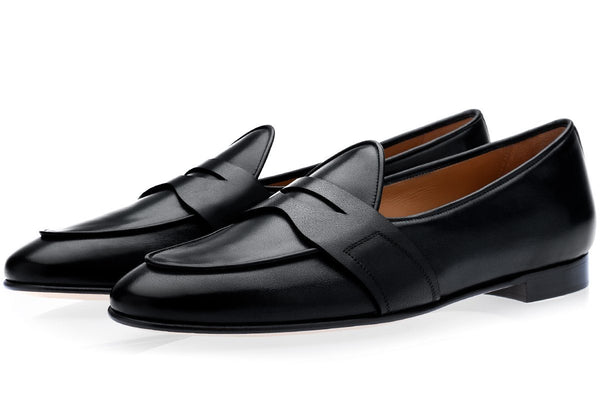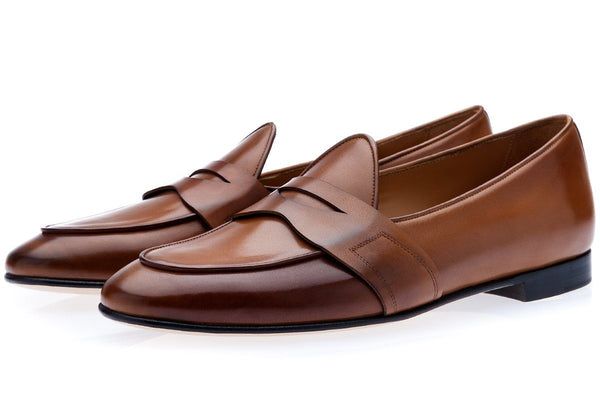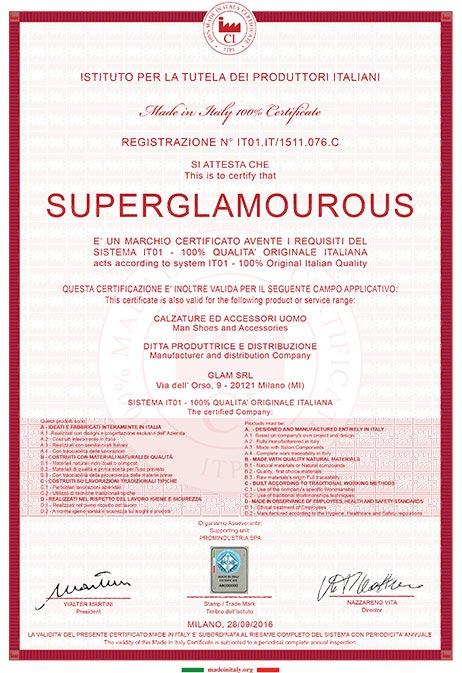Penny loafers are a classic staple in footwear, but have you ever wondered about their curious name?
The tale of the penny loafer begins in the early 20th century, tracing its roots to a blend of practicality and style. Originating as a comfortable shoe designed for easy wear, the penny loafer quickly became a fashion icon with a unique twist.
The name itself is steeped in history, harking back to a time when a penny could be slipped into the shoe's front slot for both decoration and utility. Join us as we delve into the fascinating evolution of penny loafers and uncover the stories behind their enduring charm.
The Beginnings of Penny Loafers
Delving into the history of penny loafers takes us back to the early 20th century, a time of change and innovation in footwear.
These shoes, known for their slip-on design, began as a practical solution for casual wear. Their emergence marked a shift in fashion, blending comfort with an eye-catching style.
Early 20th Century Footwear
In the early 1900s, footwear was primarily utilitarian, prioritising durability over style. Men's shoes were often bulky and laced. However, as leisure time increased, there was a growing demand for shoes that were easy to wear and comfortable.
This period saw the introduction of slip-on shoes, which were originally designed for agricultural workers who needed practical footwear without compromising ease of use.
The fashion industry quickly adapted these designs, offering more refined versions to the general public. Slip-on shoes became increasingly popular, setting the stage for the arrival of loafers.
As these shoes entered mainstream fashion, their design began to evolve, incorporating various elements of craftsmanship that balanced aesthetics and functionality.
The Rise of Loafers
The loafer's journey from utility to fashion staple began in Norway. In the 1930s, Norwegian shoemaker Nils Gregoriusson Tveranger created a moccasin-like shoe known as the "Aurland moccasin." These shoes were comfortable and easy to slip on, gaining popularity among Europeans and travellers.
American brands soon adopted the design, leading to the introduction of the Weejun loafer by G.H. Bass & Co. This shoe featured a simple yet elegant silhouette, making it a hit across the United States. The ease of wearing loafers appealed to a broad audience, from students to working professionals, cementing their place in everyday fashion.
Evolution of the Design
As penny loafers gained traction, their design evolved to reflect changing tastes and cultural influences. Initially, they featured a plain leather strap across the vamp. However, designers began experimenting with different materials, colours, and embellishments.
This evolution included adding tassels, adopting suede materials, and introducing various stitching patterns. The classic penny slot, which would later become iconic, was added as a decorative element. This constant evolution ensured that penny loafers remained relevant and stylish across decades, adapting to the shifting landscape of fashion trends.
The Name 'Penny Loafers'
The story behind the name "penny loafers" is as fascinating as the shoes themselves. This section explores the myths, cultural influences, and trends that led to the unique name we know today.
The Penny Slot Myth
A popular myth surrounding penny loafers is the idea that the slot on the shoe was designed to hold a penny. This penny slot supposedly served as an emergency payphone fund, a necessity in a time before mobile phones. While this explanation is charming, it’s more folklore than fact.
The penny slot was actually a decorative feature introduced by G.H. Bass & Co. to give the shoes a distinctive look. Over time, the habit of placing a penny in the slot became a playful trend among wearers. Despite its mythical origins, the penny slot remains a beloved feature and a conversation starter.
College Campus Trends
The mid-20th century saw college students adopting penny loafers as part of their everyday attire. This trend played a significant role in popularising the shoes across the United States. Students were drawn to the loafers' combination of style and comfort, making them ideal for campus life.
On campuses, placing a penny in the slot became a tradition, symbolising college spirit and individuality. This practice was both a fashion statement and a fun way to personalise one's shoes. The trend quickly spread, solidifying the loafers' status as a timeless classic.
Cultural Influence on Naming
Cultural influences have always played a role in fashion naming conventions. The term "penny loafer" is a prime example of how cultural phenomena can shape language. The unique name reflects the playful and innovative spirit of the era, capturing the essence of the time when these shoes first became popular.
Over the years, the name stuck, becoming synonymous with the classic design we associate with penny loafers today. This cultural impact extends beyond just the name, as penny loafers continue to embody a sense of timeless elegance in modern fashion. Their naming history is a testament to their enduring appeal and cultural significance.
Penny Loafers in Popular Culture
Penny loafers have been more than just a fashion statement. They have become a symbol of style across various media, from films to global fashion runways. This section delves into their presence in popular culture and their journey to becoming iconic.
Hollywood's Role in Fashion
Hollywood has long been a trendsetter in fashion, and penny loafers were no exception. Many leading actors sported these shoes in movies, making them highly desirable. Film stars' influence extended beyond the silver screen, affecting how the public perceived and adopted fashion trends.
These shoes were featured in classic films, cementing their place in the cultural zeitgeist. As audiences sought to emulate the styles seen on screen, penny loafers became a must-have item. Hollywood's embrace of loafers played a pivotal role in their rise to fame, influencing both fashion and popular culture.
Iconic Figures and Their Loafers
Throughout history, several iconic figures have been known for their love of penny loafers. From artists to politicians, these individuals helped popularise the shoes, showcasing their versatility and appeal.
-
James Dean often wore penny loafers, contributing to their rebellious and cool image.
-
John F. Kennedy was frequently seen in loafers, adding a touch of sophistication and class.
-
Fashion icons like Audrey Hepburn also donned penny loafers, highlighting their adaptability across genders and styles.
These figures' influence helped maintain the shoes' status as a timeless fashion choice, admired and emulated by many.
The Loafer's Global Appeal
Beyond Hollywood, penny loafers have captivated international audiences, transcending cultural boundaries. Their simple yet elegant design appeals to a wide range of fashion sensibilities, making them a staple across different cultures.
Countries around the world have embraced loafers, incorporating them into traditional and contemporary styles. Their global appeal highlights the universal desire for fashion that balances style and practicality. Penny loafers have become a symbol of cross-cultural exchange, reflecting the interconnectedness of global fashion trends.
Penny Loafers' Fashion Evolution
Penny loafers have evolved alongside changing fashion trends, adapting to new styles while retaining their classic essence. This section explores how the design has transformed over the decades and how it continues to influence modern fashion.
Design Variations Over Decades
The design of penny loafers has seen numerous variations over time. From the original leather versions to modern interpretations, each decade has brought new styles and materials.
-
1940s-1950s: Introduction of suede and tassel embellishments.
-
1960s-1970s: Experimentation with different colours and patterns.
-
1980s-1990s: Incorporation of metallics and platform soles.
These variations reflect the dynamic nature of fashion, as designers continually seek to innovate and reinvent classic styles. The evolution of penny loafers demonstrates their adaptability and enduring appeal in an ever-changing fashion landscape.
High Fashion Meets Casual Style
Penny loafers have successfully bridged the gap between high fashion and casual style. Renowned designers have embraced these shoes, incorporating them into both luxurious and everyday collections. This versatility has cemented their place in the fashion world.
High-end fashion houses have introduced their own versions of penny loafers, elevating their status from casual footwear to a symbol of elegance. This fusion of styles has broadened their appeal, attracting fashion enthusiasts from various backgrounds. Penny loafers continue to play a crucial role in the intersection of casual and high fashion.
Loafers in Modern Wardrobes
In contemporary fashion, penny loafers maintain their status as a wardrobe staple. Their timeless design allows them to complement a wide array of outfits, from business attire to casual ensembles. This versatility makes them a favourite choice for many.
-
Suitable for both formal and informal settings.
-
Available in a range of materials and colours.
-
Effortlessly stylish, adding a touch of class to any look.
Modern wardrobes often feature loafers as a go-to option for those seeking both comfort and style. Their enduring popularity is a testament to their adaptability and timeless appeal.
The Legacy and Future of Loafers
As fashion evolves, so too do penny loafers. This section explores their lasting impact and how they continue to influence future trends and innovations in the fashion industry.
Enduring Popularity
The enduring popularity of penny loafers is a testament to their timeless design and universal appeal. They have successfully navigated changing fashion trends, remaining a constant in wardrobes worldwide. Their ability to adapt to new styles while retaining their classic charm ensures their continued relevance.
-
Timeless design that suits all ages.
-
Versatility across various fashion styles.
-
Enduring appeal in both casual and formal wear.
Penny loafers' lasting popularity highlights their significance as a staple in the fashion world, admired for their elegance and practicality.
Loafers in Sustainable Fashion
As sustainability becomes a priority in fashion, penny loafers have adapted to meet these demands. Many brands now focus on eco-friendly materials and ethical production methods to create sustainable footwear options.
-
Use of recycled materials and sustainable leather.
-
Emphasis on ethical manufacturing processes.
-
Promotion of long-lasting, high-quality products.
These efforts align with the growing movement towards responsible fashion, ensuring that penny loafers not only remain stylish but also environmentally conscious. Their role in sustainable fashion reflects their ability to evolve with the times.
Future Trends and Innovations
Looking ahead, penny loafers are poised to continue evolving, incorporating new trends and technologies. The future of loafers will likely see innovations that enhance comfort, functionality, and style.
-
Integration of smart technology for enhanced comfort.
-
Exploration of new materials and design techniques.
-
Continued focus on sustainability and ethical production.
These future trends and innovations promise to keep penny loafers at the forefront of fashion, ensuring their relevance for generations to come. As they evolve, penny loafers will undoubtedly continue to inspire and captivate fashion enthusiasts worldwide.

















